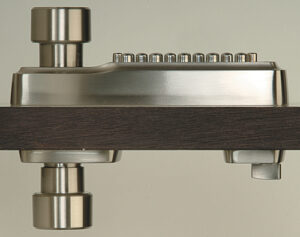 The Keylex 2100 from Securikey is an example of the growing number of mechanical code locks on the market today. The heavy duty K2100 series is available with knob or lever action operation for use with mortice deadlocking latch or mortice sashlock. A further version is compatible with rim lock panic bars for escape door applications. The lock comes as a complete assembly with the sashlock or latch as applicable.
The Keylex 2100 from Securikey is an example of the growing number of mechanical code locks on the market today. The heavy duty K2100 series is available with knob or lever action operation for use with mortice deadlocking latch or mortice sashlock. A further version is compatible with rim lock panic bars for escape door applications. The lock comes as a complete assembly with the sashlock or latch as applicable.
The unit provided for evaluation was a K2100L lever action (to both sides) double action deadlocking latch in satin chrome finish. Construction of the mechanical code door furniture is very solid and has been designed for high traffic applications where several hundred operations may be required daily. Consequently the product is somewhat bulkier than some similar products on the market.
The unit is suitable for mounting on timber, metal, UPVC and composite doors and is supplied with good installation instructions that include drilling templates for door furniture, mortice latch and strike plate. Installation itself is a straightforward affair for anyone with basic lock fitting skills. Lever action units are supplied handed so this needs to be specified when ordering.
Setting of the code should be completed before final fitting of the lock since the furniture has to be removed for this to take place. The code is determined by the orientation of the hooks within the external (insecure) lock furniture. Setting the code is straightforward although care needs to be taken when removing the back plate (matrix) so as not to take any hooks out with the matrix. The chosen code is selected by reversing the hooks as required such that their copper coloured end is not showing. There are 14 digits (0-9 + A-D) providing in excess of 16,000 combinations, although the manufacturer generally recommends use of 3-6 digits only.
The lock uses a double action deadlocking latch that locks every time the door is closed. From the insecure side, the code has to be entered to override the deadlock and retract the latch. Free egress is provided from the secure side.
Operation requires the digits to be reset using the ‘Cancel’ button above the 14 digits. It is simply a matter of then pressing the allocated code buttons firmly followed by the ‘Release’ button found below them. This will enable the door lever/knob to be operated once only.
As with other mechanical code locks, the buttons relating to the ‘code’ may actually be operated in any order.
With the latch held back via the handle, the lock may be set for ‘free’ operation via the thumbturn located above the handle on the secure side. The latch still engages each time the door closes but enables continuous operation of the handle from the secure side until such time as the thumbturn is returned to the normal locked position. A key override facility is also available as an option, although the cylinder is located on the base of the door, requiring the key to be inserted vertically to the underside of the lock furniture which looks a little awkward.
The deadlocking latch assembly itself uses a nylon snib and nylon insert on the bearing surface of the latch bolt for smoother operation of the deadlocking mechanism. This begs the question as to how well the nylon will stand up to heavy traffic use.
Several options are available such as rebate kits, coded entry/exit and escape door versions.
Overall, the product is well made, feels very solid to operate and should give prolonged reliable use.
Score: 8.5 out of 10



